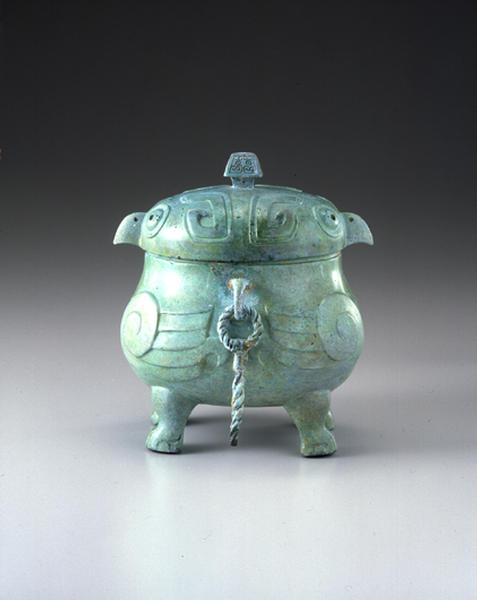鴟梟卣
- 中国・殷後期(安陽期)
- 12-11cB.C.
- 青銅
- H-17.9 D-13 W-15.6
解説(開館1周年記念展)
この扁壷形の有蓋提梁付ゆうは,全体で2羽の梟が背中合わせになった,いわゆる鴟梟ゆうの形態をしている。蓋の中央には逆さ饕餮文の施された屋根形の鈕が付けられ,長軸の両端に猛禽の嘴が突き出し,大きい丸い目が作り出されている。器壁に2組の翼が浮彫され,簡略な爪意匠を施した2組の鳥脚がその器を支えている。短軸に渡された撚縄状の提梁は,今はほぼ中央で破損しているが,簡略な犠首の付いた環耳で器に取り付けられている。
安陽期に見られるゆうと呼ばれる器の形態には,大きくは細壷ゆうと扁壷ゆうが挙げられるが,どちらにも梟がその器の主要な意匠となっているものが見られる。梟の意匠自体は安陽期の他の形態の器にも見られるが,等しくその膨らんだ器腹の形状に梟の形態を当てはめたものである。特に扁壷ゆうは安陽後期に鳥が内側を向いて対峙する意匠をもった無梁四脚のものから,このゆうに類する短軸に提梁をもった鴟梟形へ,さらに安陽期末のMIHO MUSEUM所蔵のゆう*1 に見られるような,蓋の両端に梟の嘴の痕跡を残して饕餮文が主要な意匠となった圏足形のものへと至る系列が考えられている。*2
安陽後期の鴟梟形ゆうには,生地が雷文で埋められているものと,このゆうのような雷文のないものとがあり,環耳に施された犠首の簡略な表現は,必ずしも安陽後期よりも下るものではない。類例として山西省石楼県二郎坡出土のゆう*3 があげられる。
1 MIHO MUSEUM南館図録/1997 no.78
2 水野清一/殷周青銅器と玉/東京1959
3 文物1958年第1期;山西人民出版社/山西文物選粋/山西省1989
Catalogue Entry
This lidded elliptical vessel with a bail handle is a kind of you with a shape like a pair of owls standing back to back, representing the so-called owl you. The roof-shaped pull placed in the center of the lid bears the inverted taotie design. On either end of the long axis, the beak of the owl protrudes, flanked by a pair of round eyes. Two pairs of wings are bas-reliefed on the sides of the vessel, which are supported by two pairs of feet with simple talon-pattern. The short handle resembling braided rope spanning the short axis has corroded and broken in the center. Somewhat plain semi-circular rings with a design of an animal's head attach the handle to the body of the vessel.
You came in two shapes in the Anyang period cylindrical and elliptical but their common, major design elements recall owls. The owl design itself can be found in other types of vessels in the Anyang period, where the owl skillfully fitted into the bulging shape of the vessel. A stylistic evolution of the following sort can be proposed: a beginning phase in which four-legged, handleless you were created with the design of two owls facing each other, followed by the next phase in which a handle was attached to the vessel spanning the short axis on a you, with a design of two back-to-back owls, and a final stage in which you are exemplified by one at the Miho Museum (cf. Catalogue of the South Wing, no. 78).*1 In this last phase, the Miho Museum piece attests to common elements of these you at the end of Anyang period a pair of beak-like projections on the lid, dominant use of taotie design, and the elliptical base.*2
The surfaces of the back-to-back owl you dated to the late Anyang period are left plain without the usual thundercloud design. The rather plain animal-head design on the rings for the bail handle should not be considered to be evidence that the present piece should be dated later than the late Anyang period. A similar example can be found in the you from Erlangpo Shilouxian, Shanxi province.*3

